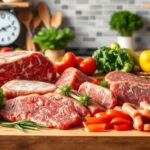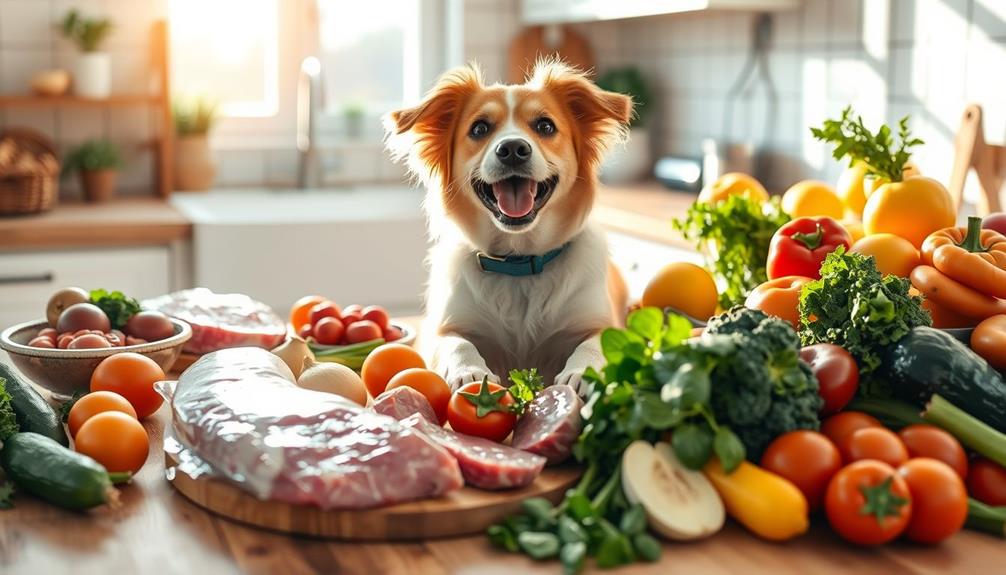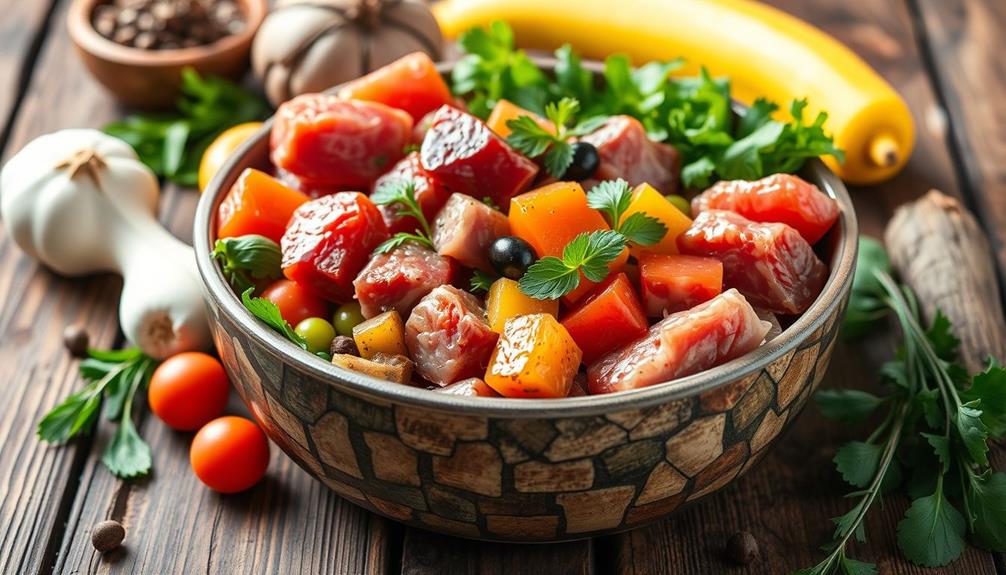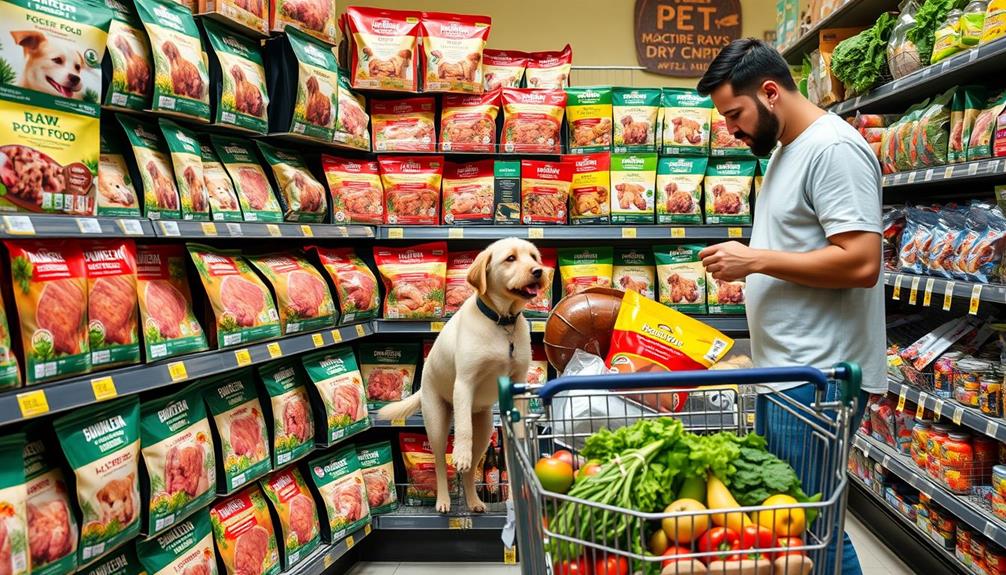To calculate how much raw food to feed your dog, start by determining their ideal adult weight. Generally, you'll want to feed 2% to 3% of that weight. For small dogs or puppies, increase the percentage to 5% to 10% based on their current weight. Adjust portions based on activity level—active dogs may need more while less active or overweight dogs require less. Regularly check your dog's weight and health, adjusting the food as needed. This guarantees they get the right nutrition. There's plenty more to explore about balancing their diet and health needs! When determining raw food quantities for dogs, it’s important to consider their specific nutritional needs and any dietary restrictions they may have. Some dogs may require additional supplements, such as fish oil or joint support, which should also be factored into their overall diet plan. Consulting with a veterinarian or a pet nutritionist can provide valuable insights and guidance on ensuring your dog receives a well-balanced and appropriate raw food diet. Taking the time to educate yourself on your dog’s dietary requirements will help you provide them with the best care possible.
Key Takeaways
- Determine your dog's ideal adult weight and base daily portions on 2% to 3% of this weight.
- For smaller dogs (up to 5 lbs), increase portions to 5% to 6% of their body weight.
- Active dogs require 2.5% to 3% of their body weight in raw food, while less active dogs need 1.5% to 2%.
- Monitor your dog's weight regularly to adjust portions as needed and ensure optimal health.
- Use a raw food calculator to personalize recommendations based on your dog's specific dietary needs.
Understanding Raw Food Diet Benefits
Understanding the benefits of a raw food diet for your dog can be eye-opening. This approach to nutrition can greatly enhance your dog's health in various ways.
First, you'll likely notice a shinier coat and healthier skin, thanks to the high-quality nutrients found in raw ingredients. Dogs on a raw food diet often absorb nutrients better than those eating kibble, leading to improved overall health.
Additionally, providing a balanced diet with fresh ingredients can contribute to better digestion and a healthier weight, as seen in the ultimate hamster care guide.
You might also find that your dog experiences enhanced energy levels and liveliness post-transition. This increased energy can manifest in more playful behavior and greater enthusiasm during walks.
Additionally, a raw diet supports dental health; the natural chewing action helps reduce plaque buildup and promotes healthier gums.
For dogs with dietary restrictions, switching to a raw food diet can also help reduce allergens and food sensitivities, providing much-needed relief.
As you consider the benefits of a raw food diet, think about how these changes can positively impact your furry friend's life.
Ultimately, giving your dog the right nutrition can lead to a happier, healthier companion.
Determining Portion Sizes
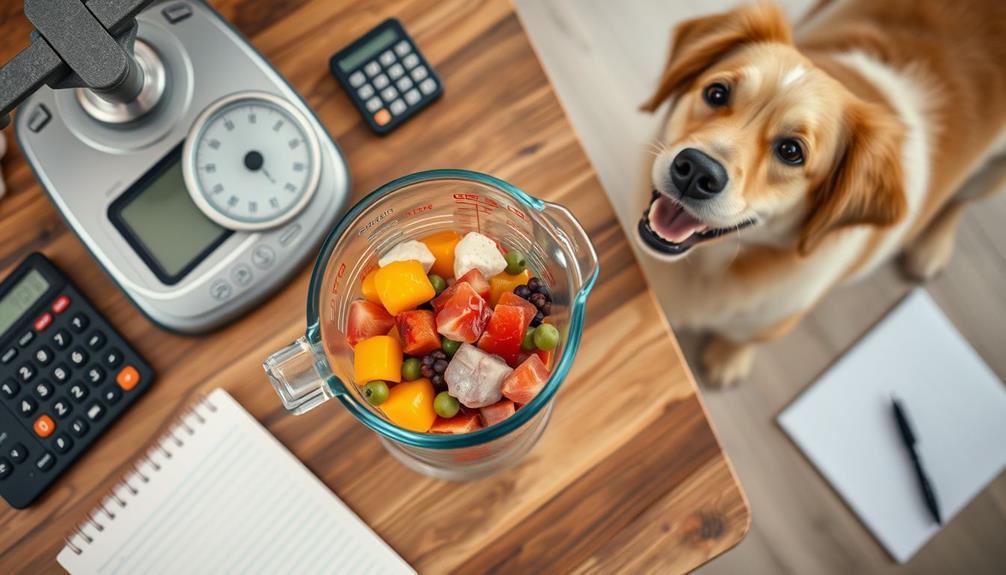
Determining the right portion sizes for your dog on a raw food diet is essential for their health and well-being. To calculate the daily portion, you'll want to base it on 2% to 3% of your dog's ideal adult weight. For instance, if your dog weighs 50 lbs, you should aim for about 1 lb (16 oz) of raw food each day, calculated as 50 lbs x 0.02.
It's also important to take into account any specific dietary needs your dog may have, such as allergies or sensitivities, which can influence the types of raw food you select. Additionally, the importance of selecting the right cold medication for effective relief can be analogous when ensuring your dog receives the right nutrition.
Keep these points in mind when calculating the amount of raw food:
- Smaller dogs (up to 5 lbs) may need 5% to 6% of their body weight to meet energy demands.
- Puppies typically require 5-10% of their current weight in raw food daily, tapering down to about 5% by six months.
- Regularly monitor your dog's weight and adjust portion sizes accordingly.
Using a raw food calculator can help you determine the precise amount of raw food for your dog based on their adult weight and activity level.
Factors Influencing Food Amounts

Several factors influence how much raw food your dog needs, and it's imperative to take them into account for ideal health. The amount of food needed typically ranges from 2% to 3% of your dog's ideal body weight for adult dogs. If you have a puppy, they might require 5% to 10%, depending on their growth stage.
Incorporating a balanced diet rich in nutrients is also fundamental, as it supports overall health and longevity in dogs, similar to the importance of a balanced diet for humans in promoting wellness and liveliness lifestyle for longevity.
Activity level plays a significant role in determining food intake. Active dogs often need larger portions than their less active or senior counterparts. Additionally, consider external factors like outdoor temperatures; colder weather can increase your dog's caloric needs.
Regularly monitoring your dog's weight and health is critical, especially during the initial shift to a raw diet. Adjust portions as necessary to maintain their ideal body weight.
Using a Raw Food Calculator

Using a raw food calculator can simplify the process of determining the right amount of food for your dog. By inputting your dog's ideal weight, the raw feeding calculator provides personalized recommendations based on their activity level and dietary needs. This way, you'll know exactly how much raw food to feed your dog for a balanced diet.
Additionally, incorporating high-quality protein sources, such as those found in Healthy Dog Snacks for Happy Pets, can enhance your dog's overall energy levels and well-being.
Here are some key benefits of using a raw food calculator:
- It calculates the appropriate daily intake, typically 2-3% of your dog's weight for adults.
- You get a detailed breakdown of food components, including muscle meat, edible bone, and organ meat.
- The results can be provided in various units (lbs, oz, kg, g) and even emailed as a PDF for easy reference.
With this tool, you can guarantee your dog receives the right nutrition tailored to their specific requirements.
Whether you're shifting to an appropriate raw diet or adjusting your current feeding routine, a raw food calculator takes the guesswork out of how much raw food your dog needs. Start using one today to make feeding your furry friend easier and more effective!
Feeding Guidelines for Puppies

When it comes to feeding your puppy, portion sizes and meal frequency are essential for their growth.
To maintain good financial health, it's important to budget for quality food expenses as part of your overall puppy care plan, including setting specific targets for food costs over time.
You'll want to start by providing about 5-10% of their body weight in raw food daily, adjusting to around 5% as they grow.
Feeding three small meals a day until they're about 12 weeks old will help guarantee they get the nutrients they need.
Ideal Portion Sizes
Determining the ideal portion sizes for your puppy is essential for their growth and health. Puppies generally require about 5-10% of their body weight per day in raw food to feed, which decreases to around 5% as they reach six months of age.
To calculate appropriate raw food portions, consider the following:
- Use 2-3% of the puppy's ideal adult weight for portion sizes.
- Initially, feed about 10% of their current weight to support growth.
Understanding the importance of long-term financial planning for potential pet care expenses can also enhance your preparation as a responsible pet owner.
Gradually introduce variety in recipes starting at 5-8 weeks of age.
When determining portion sizes, remember that puppies have different needs at various stages. Nutritional supplements like fish oil and probiotics can enhance your puppy's raw diet, ensuring they receive balanced nutrition.
As your puppy grows, adjust their portions accordingly, monitoring their weight and overall health. This way, you'll help them thrive and develop into a healthy adult dog.
Always consult your veterinarian for personalized advice tailored to your puppy's specific needs and lifestyle.
Feeding Frequency Recommendations
Feeding puppies at the right frequency is vital for their growth and development. You should feed your puppy three small meals daily until they're about 12 weeks old. After that, you can reduce the feeding frequency to two meals per day. This schedule guarantees they get the right amount of nutrients and energy from their diet.
Additionally, it's significant to take into account how emotional and psychological growth can impact a puppy's behavior and appetite, as a well-adjusted puppy is more likely to thrive.
For portion sizes, aim for around 10% of your puppy's current body weight or 2-3% of their ideal adult weight. Regularly monitoring your puppy's body condition is essential to guarantee they're receiving the appropriate amount of raw food for ideal growth and health.
Adjust the feeding frequency recommendations based on your puppy's activity level, age, and individual metabolic rate. This flexibility allows you to meet their unique nutritional needs.
As you introduce a variety of protein sources, do so gradually to help your puppy develop a balanced diet. This approach also reduces the risk of food sensitivities, making sure your puppy thrives on their raw food regimen.
Following these guidelines will set a strong foundation for your puppy's health and well-being.
Monitoring Weight and Health
To keep your dog healthy on a raw diet, regularly weigh them and note any changes in body weight.
Incorporating essential oils like eucalyptus oil may help maintain your dog's respiratory health, which can be beneficial as you monitor their overall well-being.
Pay attention to their body condition score and adjust food portions based on whether they're underweight, ideal, or overweight.
Observing their energy levels, coat condition, and stool quality will also help you gauge their overall health and nutritional needs.
Regular Weight Checks
While keeping an eye on your dog's weight might seem tedious, it's vital for their health and well-being. Conducting regular weight checks at least once a month helps you monitor your dog's weight and guarantees they stay within a healthy range for their breed and age.
It's important to limit weight loss during the shift to a raw diet to just 1-2% per week to avoid health complications. Additionally, just as breast cancer screening is important for early detection, timely weight checks can help catch any potential health issues before they become serious.
By keeping a record of your dog's weight over time, you can make informed adjustments to their food intake based on trends in weight gain or loss.
Here are a few key considerations:
- Active dogs might need increased food portions to maintain a healthy weight.
- Less active dogs may require adjustments to prevent obesity.
- Consulting with a veterinarian during regular weight checks can offer tailored advice for your dog's overall health.
Health Condition Observations
Monitoring your dog's health during the shift to a raw food diet is crucial for guaranteeing their well-being. Regularly check your dog's body weight per week to keep it within a healthy range. A fluctuation of 1-2% in weight is normal during this transition, but if you notice significant changes, it's time to reevaluate their food portions.
Additionally, just as individuals with emotional dysregulation must adapt their environments for better outcomes, your dog's adjustment to a new diet may require careful observation and modifications to their feeding plan. emotional regulation is key in both human and canine health.
Besides weight, observe your dog's overall health condition. Pay attention to their energy levels, coat quality, and stool consistency; these factors can reveal how well they're adapting to their new diet.
Active adult dogs may need larger portions to meet their energy needs, while less active dogs should have reduced portions to prevent unwanted weight gain.
If you see concerning changes in weight or health, don't hesitate to consult with a veterinarian. They can provide tailored advice, especially during this initial dietary switch.
Keeping a close eye on these aspects will help guarantee your dog thrives on their new raw food diet, maintaining a healthy body weight and overall liveliness.
Adjusting Food Portions
Adjusting food portions for your dog is essential to guarantee they're thriving on a raw diet. Regularly monitor your dog's weight and overall health, especially during the shift to raw food. This period might show weight loss, but it often reflects water weight rather than fat loss.
Understanding your dog's unique astrological compatibility might also provide insights into their behavior and energy levels, which can impact their dietary needs.
To effectively manage their diet, consider the following:
- Active dogs may need an increase of about 3% of their ideal weight in food portions.
- Less active or overweight dogs should be fed only about 1.5% daily.
- Document changes in behavior, energy levels, and stool quality to evaluate your feeding plan's effectiveness.
Consult with a veterinarian to create a tailored feeding plan, particularly if you notice significant weight fluctuations or health issues.
By adjusting food portions based on your dog's activity level and body condition, you'll make certain they receive the proper nutrition they need to stay healthy.
Adjusting Diet for Activity Levels
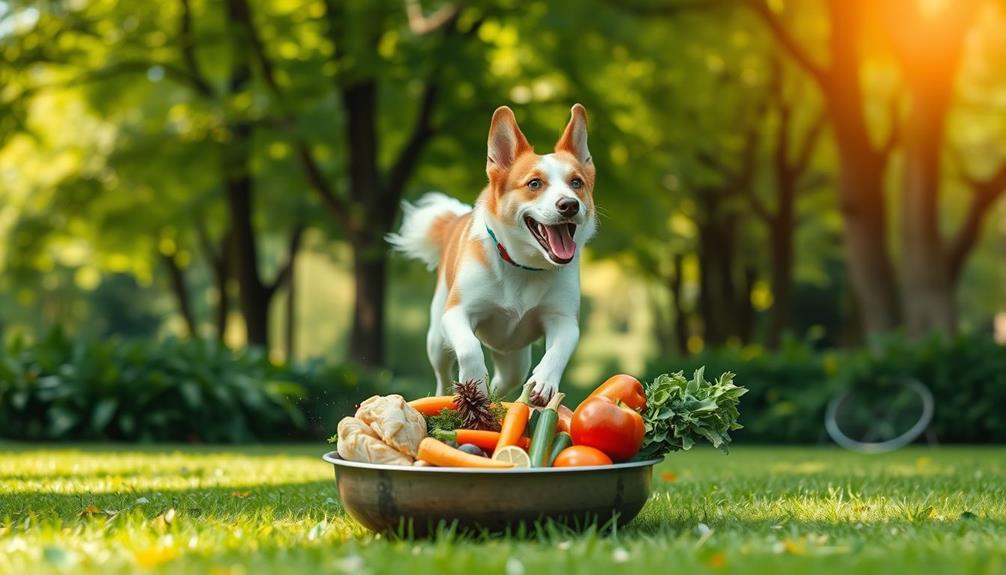
Understanding your dog's activity level is vital for determining the right amount of raw food they need. Active dogs typically require a higher percentage of their body weight in nutritious raw food, around 2.5% to 3%, while less active dogs may only need 1.5% to 2%.
When adjusting diet for activity levels, it's important to take into account how much energy your pup expends daily. If you've got a high-energy breed or a working dog, you'll need to feed your puppy more to support their active lifestyle.
Regularly monitor your dog's weight and energy levels; if they're losing weight or seem lethargic, it might be time to increase their food intake.
Also, don't forget that seasonal changes can impact your dog's activity levels. For instance, they might be more active in colder weather, necessitating a bit more food.
Consulting with a veterinarian can also help tailor feeding amounts based on your dog's specific activity levels and needs. By adjusting their diet accordingly, you can help guarantee your dog remains healthy and happy.
Quality Ingredients for Optimal Nutrition
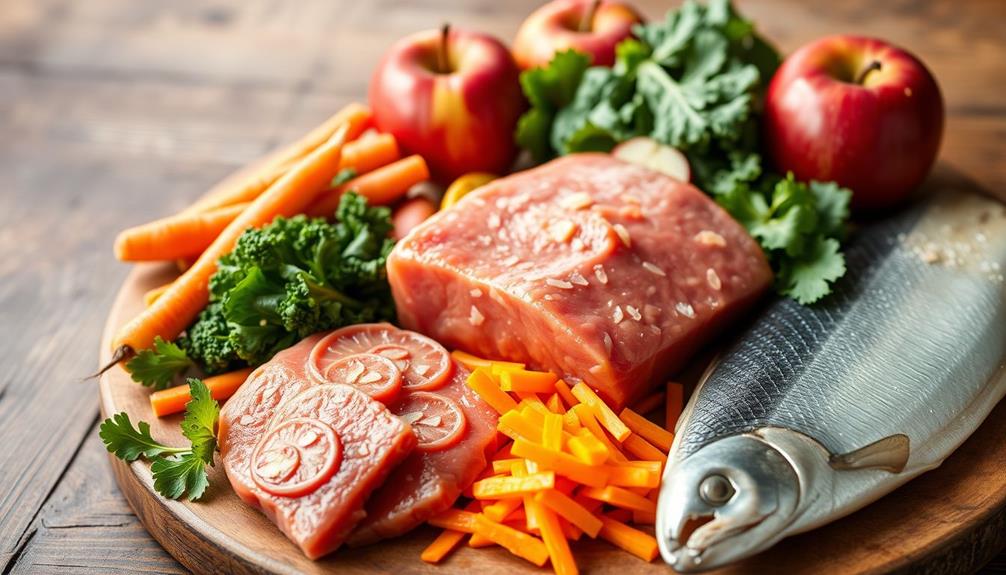
To keep your dog healthy and thriving, the quality of ingredients in their raw food matters just as much as the quantity. When selecting raw dog food, focus on sourcing high-quality ingredients that promote peak nutrition.
Look for options that are locally sourced and free from antibiotics, added hormones, and artificial additives. A balanced diet typically includes:
- Muscle meat (70-80%)
- Edible bone (10%)
- Organ meats (5-7%)
This combination provides essential nutrients and vitamins necessary for your dog's health.
Your dog's nutritional needs will vary based on factors like age, breed, and activity level, so adjust the diet accordingly to support their overall well-being.
Choosing raw dog food brands that prioritize ingredient transparency can greatly influence your pet's health and nutritional intake.
It's important to regularly assess your dog's dietary needs and monitor how they respond to their food. By being attentive to these details, you can guarantee that you're meeting their nutritional needs effectively, leading to a happier, healthier pup.
Quality ingredients are key to achieving a balanced diet that fosters long-term health.
Frequently Asked Questions
How Much Raw Food Should I Feed My Dog Chart?
You'll find charts online that detail how much raw food to feed your dog based on their weight and age. Just remember to adjust as needed, considering your dog's activity level and health.
What Is the 80 10 10 Rule for Raw Dog Food?
Imagine your active Labrador thriving on a balanced diet. The 80-10-10 rule for raw dog food means you'll feed 80% muscle meat, 10% edible bone, and 10% organ meat to guarantee peak health and nutrition.
What Are the Proportions for Raw Dog Food?
The proportions for raw dog food typically include 70-80% muscle meat, 10% edible bone, and 5-7% organ meats. You should also consider adding about 7% vegetables for balanced nutrition in your dog's diet.
How Do I Calculate How Much Food to Feed My Dog?
When it comes to feeding your dog, you've gotta know your stuff. Start by considering their weight and activity level, then adjust food amounts accordingly. Regularly check their health to stay on the right track.
Conclusion
In summary, figuring out how much raw food to feed your dog doesn't have to be an intimidating task. By understanding their needs and monitoring their health, you'll hit the nail on the head in no time. Remember to adjust portions based on their activity levels and always choose high-quality ingredients for the best nutrition. With a little patience and care, you'll make sure your furry friend thrives on their raw food diet!








